
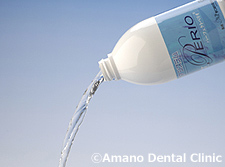
For mild, moderate to severe conditions of gingivitis or periodontal disease, we provide the in-clinic treatment with high concentration of electrolyzed hypochlorite water.
The treatment has numerous advantages over traditional periodontal treatment, which include few office visits and no surgical procedures to the gum.
Another advantage is that Electrolyzed Hypochlorite Water provides a high level of bacteriolysis.
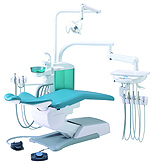
*Treatment completed in a period of time
For moderate to severe periodontal disease, traditional treatments require months of office visits to disinfect the mouth. Because the in-clinic Electrolyzed Hypochlorite Water treatment can completely kill bacteria, only a few office visits are needed. Normally, we required only one office visit for mild conditions, twice for moderate cases and three times for severe cases.
*Electrolyzed Hypochlorite Water Home Care treatment will be needed after the in-clinic treatment.
*For severe periodontal disease or gum recession due to malocclusion, additional crown or orthodontic treatment may be necessary and may need more than three office visits.
*Surgical gum treatment procedure rarely needed
It was common to treatment moderate to severe periodontal disease with surgical procedures, called flap operations in which the gums are cut and opened to scrape the plaque and infected areas. The in-clinic Electrolyzed Hypochlorite Water treatment can remove the plaque built up inside of the gums without surgery.
*Kills bacteria completely
Traditional periodontal treatment mainly scrapes off plaque using machines, disinfects the inside of the gum using a soft tissue laser or use oral antibiotics. The treatment, however, only slightly reduces the periodontal bacteria count at the cellular level and has a high probability of recurring symptoms.
[Photomicrograph of the inside of the mouth]
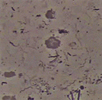 →
→ 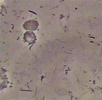 →
→ 
Before removing plaque After applying Electrolyzed Hypochlorite Water After a soft tissue laser treatment
The images from “Periodontal Diseases and Oral Malodor Innovative HCIO Treatment” by Dr. Munenori Noguchi
Also, the traditional treatment may introduce periodontal bacteria into the blood stream during the procedure. An in-clinic Electrolyzed Hypochlorite Water treatment can kill periodontal and cavity-producing bacteria at cellular levels with a microscopy.
Therefore, a possibility of recurring periodontal disease is minimal.
electrolyzed hypochlorite water treatment offers three steps depending on whether the symptoms are mild, moderate or severe.
*Step 1 – For mild symptoms
[ Perio Treatment ]
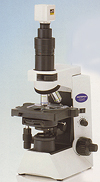
Perio Treatment first involves assessing the amount of bacteria using a microscopic and a bad-breath detector, and disinfecting the inside of the mouth.
The treatment will focus on sterilizing the bacteria that causes periodontal diseases before removing plaque to avoid the introduction of the bacteria into the blood stream.
Once the treatment is completed, a microscopic examination will be conducted to ensure that no bacteria is present.
 →
→ 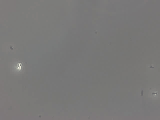
Micrograph movie of the inside of the mouth After Perio Treatment
*Patients with a small amount of plaque and with mild symptoms will finish up in-clinic Perio Treatment and will move onto Electrolyzed Hypochlorite Water Home Care.
*Step 2 – For moderate symptoms
[ Cleaning Treatment ]
After Step 1 of Perio Treatment, visible plaque above the gum line will be removed using a 450ppm higher concentration of electrolyzed hypochlorite water.
This process will also kill the bacteria that causes periodontal disease and cavities. Because cavity bacteria often helps periodontal bacteria attach to the teeth, we may also inspect the levels of cavity bacteria and bad breath before the treatment.
Once the treatment is completed, the microscopic examination will be conducted again to ensure if the bacteria is completely gone.
*Patients without plaques in the gum and with moderate symptoms will finish up in-clinic Cleaning Treatment and will move onto Electrolyzed Hypochlorite Water Home Care.
*Step 3 – For severe symptoms
[ Telescope Treatment ]
After Perio Treatment and Cleaning Treatment, Telescope Treatment will be applied to remove invisible plaques below the gum line and to disinfect the bacteria.
Because a microscope enables us to see detailed portions of the gum, surgical procedures are rarely needed. Once the treatment is completed, microscopic examination and bad-breath measurements will determine whether the bacteria is completely gone.
*Patients will then move onto Electrolyzed Hypochlorite Water Home Care.
*Patients with severe symptoms or with gum recession due to malocculusion may need additional crown or orthodontic treatment.

This patient interrupted orthodontic treatment years ago, but he wore braces for a long time. Due to the braces, he could not brush the teeth properly. This unfinished treatment affected the alignment of the teeth, which also caused the swollen gums and the shifted teeth. He exhibited other problems, including an unfitted partial denture on the upper jaw. We also found that he had Dry mouth (xerostmia) indicated by a whitish gum color. He had also developed gingivitis. Although the bone structure was already corroded, we also determined that tooth extraction would not be necessary.
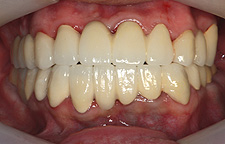
The second photograph shows the teeth after the treatment. We first removed the braces and provided periodontal treatment with high concentration of Electrolyzed Hypochlorite Water electrolyzed hypochlorite water to kill bacteria. Implant-supported bridges were used to connect all the teeth and to support the shifting teeth, which were caused by the receding bone structure. The upper partial denture was also replaced with bridged crowns. Having the healthy gums is back, he is now able to enjoy meals. He continues with preventative treatment using Electrolyzed Hypochlorite Water Home Care to avoid gingivitis-causing bacteria.
The gum discoloration due to Dry mouth (xerostmia) was also gone.
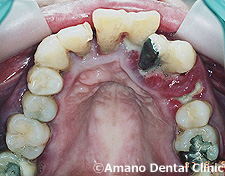
This patient complained about swollen gums. We determined that the back teeth met at the lower position than the front teeth when biting down, which was resulted in placing extra pressure on the front teeth. This was the result of the gums being swollen. We diagnosed the fundamental problem was a retrusive lower jaw (retrusive occlusion). In this case, the bite needed to be corrected to take the extra pressure off from the front teeth. Read about a retrusive lower jaw.
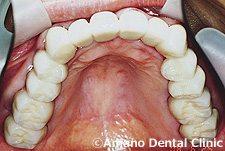
The second photograph shows the teeth after the treatment. Because she had shifting teeth due to receding bone structure, all teeth were connected and fixed with implant-supported bridges to support the shifting teeth. The back teeth bite position was leveled to restore the ideal occlusion. The front and the back teeth were evenly touched, and a healthy balanced bite was back. For periodontal treatment, we disinfected bacteria causing periodontal diseases and cavities with high concentration of electrolyzed hypochlorite water. After the in-clinic treatment, she has been using Electrolyzed Hypochlorite Water Home Care to keep her mouth free from periodontal bacteria.
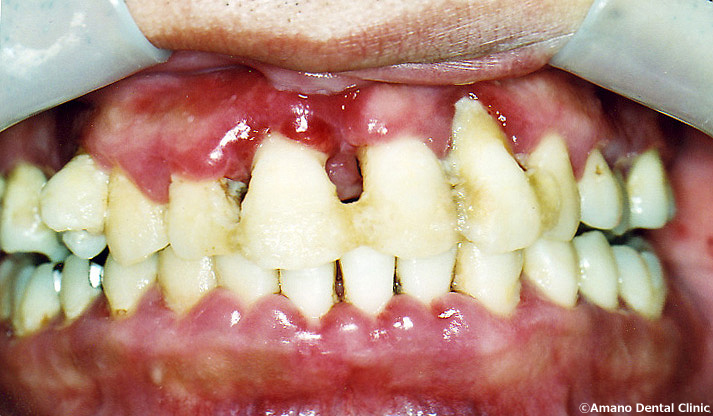
This patient complained about his front gums swollen and many shifting teeth. He showed the symptoms of advanced gingivitis. Because the back teeth had also shifted, the bite position got lower which caused unbalanced stress on the teeth. He was suffering from retrusive occlusion.
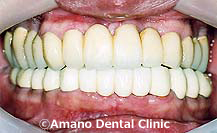
The second photograph shows the teeth after the treatment. We connected and stabilized all the teeth with implant-supported bridges to support shifting teeth. Only two of the 14 upper teeth were removed due to severe gingivitis. The remaining 12 teeth were preserved. Because a stable occlusion (cuspid guidance) was established with implants, the front and the back teeth now receive balanced pressure. We provided periodontal treatment using high concentration of Electrolyzed Hypochlorite Water electrolyzed hypochlorite water to disinfect gingivitis-causing bacteria. He continues onto Electrolyzed Hypochlorite Water Home Care treatment to keep the mouth clean from the bacteria. He now enjoys healthy teeth and gums
Read details about the stable bite(cuspid guidance occlusion)